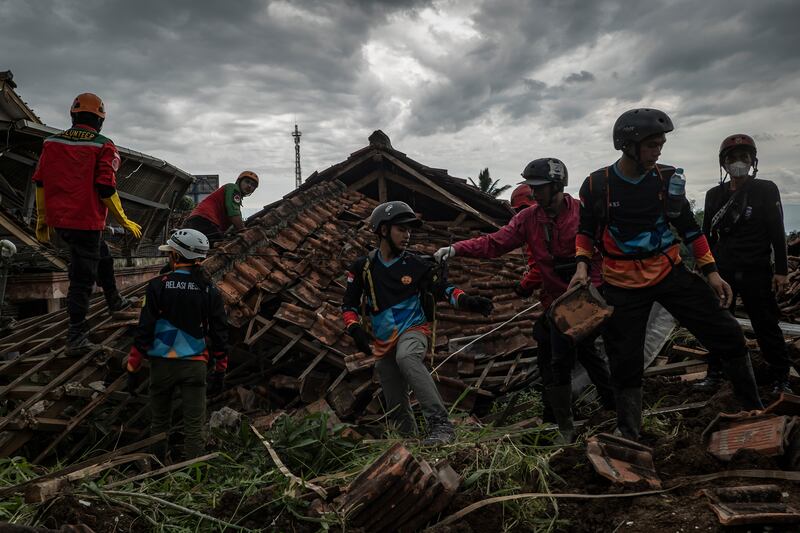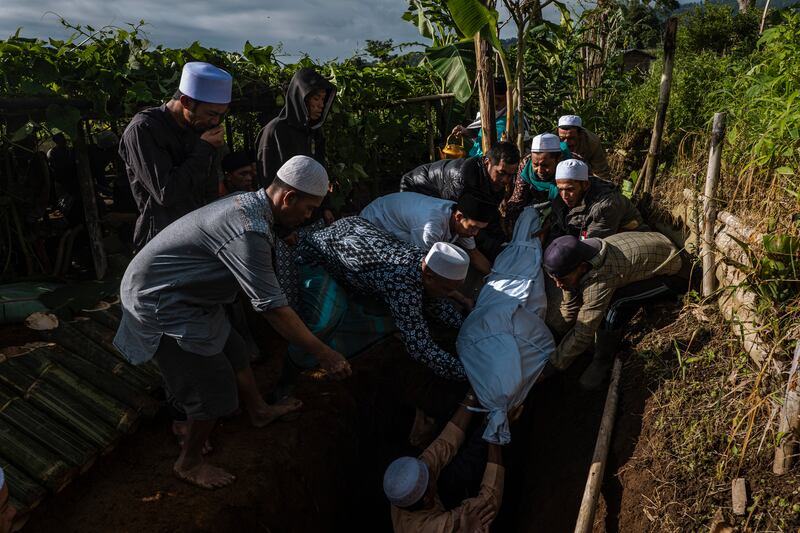Like most other children across Indonesia, Dewi Hani (4), typically spent her afternoons studying at an Islamic school. She had been learning to write the Arabic alphabet in a notebook that she kept inside her blue backpack, along with a pencil and a Koran.
This Monday afternoon was no different – until the moment when a 5.6-magnitude earthquake flattened structures in the area. Hani was one of five students killed when her two-story Islamic school collapsed in a village a few dozen miles from Indonesia’s capital, Jakarta.
Hani’s mother, Neng Didah (34), rushed to the school and saw its second floor sitting on the ground. The first floor – where her daughter studied – had disappeared.
“I suddenly felt weak,” Neng said Thursday in the village, Sarampad. “I heard voices calling, ‘Mama, Mama, Mama,’ but I didn’t recognise any of them.”
READ MORE
The official death toll from the quake, which struck a mountainous area of the country’s main island, Java, was 310 as of Friday. There may be significantly more. Officials say it is already clear that about one-third of the dead were children, many of whom were trapped in homes or schools that crumbled.
The extent of the structural failures has called attention to what experts say is a persistent problem in Indonesia: a glaring disparity between building quality in urban and rural areas.
Even though Indonesia has building codes, they are “difficult to enforce, and there is a lack of supervision and enforcement from the government, especially in rural areas,” said Elisa Sutanudjaja, the executive director at the Rujak Center for Urban Studies, a research institute in Jakarta.

‘Hotbeds’ of Disaster
Large and small earthquakes occur virtually every day in Indonesia, a country of about 270 million people that sits at the meeting point of several tectonic plates and along an arc of volcanoes and fault lines. Devastation from powerful earthquakes has been exacerbated by landslides caused by deforestation, small-scale mining and urban development.
“They are all going to get worse, because climate change is going to make them worse,” said Benjamin P Horton, director of the Earth Observatory of Singapore.
Major earthquakes have added urgency to an effort to raise construction quality across Indonesia to standards that aim to make homes and other buildings able to withstand earthquakes without collapsing. But recent earthquakes have exposed a wide gulf between urban and rural building standards. In one example, the destruction of buildings after an earthquake hit the island of Lombok in 2018 was mainly attributed to “design inconsistency,” including non-compliance with rules on structural reinforcement, according to a July study on Indonesian building codes.
Kerry Sieh, a seismologist who has studied Indonesia, said that government offices, hotels and other large buildings, particularly in Jakarta, have been brought up to specification and would be very safe during earthquakes.
But one- or two-story buildings are more common across the country outside cities, he said. Many are built with too little reinforcing iron and poor-quality concrete, and they tend to collapse when earthquakes shake them.
Indonesia’s national building codes were mostly adapted from those of New Zealand and the United States. Municipalities are required to produce their own codes, along with disaster risk assessments and spatial-planning regulations.
But only about 30 per cent of them have produced their own building codes, and many that have codes cannot enforce them because of lack of funding and staffing, or geographical challenges, Sutanudjaja said. In rural areas, many houses are built by their occupants, and the quality of the construction depends on their socioeconomic situation, she added. “Oftentimes, even in a big city like Jakarta, the planning document does not correspond with the risk assessment,” she said. “So, basically, many settlements are already hotbeds for the next natural disaster, such as earthquakes.”

‘God Didn’t Save Her’
The earthquake that struck Java on Monday concentrated its power on Cianjur Regency, an agricultural region south of Jakarta.
If the brick-and-concrete structure where Hani died had been funded by the government, its contractor would have had to comply with national building codes, according to Sutanudjaja. Because it was funded privately, it had to comply instead with local codes that had been implemented in 2013.
Komariah, an official in a district within the regency who goes by only one name, said that many people in the area build on hilly terrain and cannot afford materials that would make their structures safer.
Hani’s Islamic school, known as a madrassa, went through three stages of construction, according to Muhammad Yusuf Supriatna, a volunteer teacher whose family owns the school. In 1997, it was built as a one-story, 13ft-by-30ft structure. In 2006, its dimensions were increased to 20ft-by-41ft, he said. And in 2016, a second story was added, financed by a $7,000 donation from an investor in the Middle East.
“We built this madrassa by ourselves, helped by the neighbours,” he said. “We don’t have the building permit, but I consulted with a friend who is a construction expert.”
For a quarter of a century, the madrassa withstood earthquakes without even showing a crack. But the one that struck Monday afternoon toppled the second story, killing Hani and three other girls, aged six, seven and 12, as well as a 10-year-old boy. Three other children were injured. Hani was a quiet, obedient child who had been learning how to write numbers and recognise the letters of the alphabet, her mother, Neng, said during an emotional interview. Her favourite doll was Hello Kitty, and she liked to eat rice with both salt and soy sauce.
When Hani left the house on Monday, Neng was busy frying potatoes for her husband, a street vendor. She stopped to help zip the girl’s black dress, tidy her hijab and give her about 13 cents in pocket money.
When the earthquake hit, Neng and her husband focused on helping an elderly neighbour. But after a few minutes, her husband began shouting, “Hani, where’s Hani?”
They ran to Hani’s madrassa and panicked when they saw that its second story had collapsed. Other children were crawling out through a small hole under the rubble. A teacher told them not to worry.
Neng called Hani’s name for an hour, but the girl never emerged. Officials eventually brought the couple to a nearby evacuation tent where they would be safer from the earthquake’s aftershocks.
“In the tent, I kept on praying, asking God to save her,” she said. “But God didn’t save her.”
Hani’s body was discovered around 12.30am, and she was buried nine hours later in a white shroud, an Islamic funeral custom. – This article originally appeared in The New York Times.

2022 The New York Times Company


















